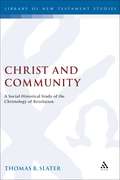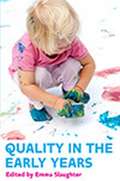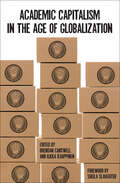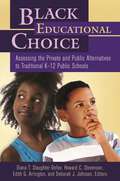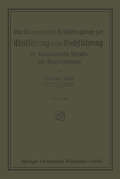- Table View
- List View
My Revision Notes: Medicine in Britain, c1250-present and The British sector of the Western Front, 1914-18 (PDF)
by Sam SlaterTarget success in Edexcel GCSE (9-1) History with this proven formula for effective, structured revision; key content coverage is combined with exam-style questions, revision tasks and practical tips to create a revision guide that students can rely on to review, strengthen and test their knowledge.With My Revision Notes, every student can:- Plan and manage a successful revision programme using the topic-by-topic planner- Enjoy an interactive approach to revision, with clear topic summaries that consolidate knowledge and related activities that put the content into context- Build, practise and enhance exam skills by progressing through activities set at different levels- Improve exam technique through exam-style questions and model answers with commentary from expert authors and teachers- Get exam ready with extra quick quizzes and answers to the activities available online
My Revision Notes: Pearson Edexcel GCSE (9–1) History: Migrants in Britain, c800–present and Notting Hill, c1948–c1970
by Sam SlaterExam board: Pearson EdexcelLevel: GCSESubject: HistoryFirst teaching: September 2021First exams: Summer 2022Target success in Pearson Edexcel GCSE (9-1) History with this proven formula for effective, structured revision.Key content coverage is combined with exam-style questions, revision tasks and practical tips to create a revision guide that students can rely on to review, strengthen and test their knowledge.With My Revision Notes every student can:> Plan and manage a successful revision programme using the topic-by-topic planner> Enjoy an interactive approach to revision, with clear topic summaries that consolidate knowledge and related activities that put the content into context> Build, practise and enhance exam skills by progressing through activities set at different levels> Improve exam technique through exam-style questions and sample answers with commentary> Get exam ready with extra quick quizzes and answers to the activities available online
My Revision Notes: Pearson Edexcel GCSE (9–1) History: Migrants in Britain, c800–present and Notting Hill, c1948–c1970
by Sam SlaterExam board: Pearson EdexcelLevel: GCSESubject: HistoryFirst teaching: September 2021First exams: Summer 2022Target success in Pearson Edexcel GCSE (9-1) History with this proven formula for effective, structured revision.Key content coverage is combined with exam-style questions, revision tasks and practical tips to create a revision guide that students can rely on to review, strengthen and test their knowledge.With My Revision Notes every student can:> Plan and manage a successful revision programme using the topic-by-topic planner> Enjoy an interactive approach to revision, with clear topic summaries that consolidate knowledge and related activities that put the content into context> Build, practise and enhance exam skills by progressing through activities set at different levels> Improve exam technique through exam-style questions and sample answers with commentary> Get exam ready with extra quick quizzes and answers to the activities available online
My Revision Notes: Pearson Edexcel GCSE (My Revision Notes)
by Sam Slater Steve Waugh John WrightExam board: Pearson EdexcelLevel: GCSE (9-1)Subject: HistoryFirst teaching: September 2016First exams: Summer 2018Target success in Pearson Edexcel GCSE (9-1) History with this proven formula for effective, structured revision. Key content coverage is combined with exam-style questions, revision tasks and practical tips to create a revision guide that students can rely on to review, strengthen and test their knowledge.With My Revision Notes every student can:- Plan and manage a successful revision programme using the topic-by-topic planner- Enjoy an interactive approach to revision, with clear topic summaries that consolidate knowledge and related activities that put the content into context- Build, practise and enhance exam skills by progressing through activities set at different levels- Improve exam technique through exam-style questions and sample answers with commentary- Get exam ready with extra quick quizzes and answers to the activities available onlineThis revision guide covers the following options:- Medicine in Britain c1250-present and The British sector of the Western Front, 1914-18- Early Elizabethan England, 1558-88- Superpower relations and the Cold War, 1941-91- Weimar and Nazi Germany, 1918-39
Christ and Community: A Socio-Historical Study of the Christology of Revelation (The Library of New Testament Studies #178)
by Thomas SlaterSlater presents a study of the three major christological images of Revelation and their meanings for the original audience. Employing both historical criticism and elements of sociology of knowledge, Christ and Community explores the social functions of 'one like a son of man', the Lamb, and the Divine Warrior, identifying both similarities and dissimilarities. The study argues, on the one hand, that the religious laxity found in Revelation 2-3 reflects attempts by some Christians to accommodate to provincial social pressures, while, on the other hand, Revelation 4-19 reflect the low status of Christians in the cities of Asia Minor.
Research on Teaching Astronomy in the Planetarium (SpringerBriefs in Astronomy)
by Timothy F. Slater Coty B. TatgeFrom a noted specialist in astronomy education and outreach, this Brief provides an overview of the most influential discipline-based science education research literature now guiding contemporary astronomy teaching. In recent years, systematic studies of effective and efficient teaching strategies have provided a solid foundation for enhancing college-level students’ learning in astronomy. Teaching astronomy and planetary science at the college-level was once best characterized as professor-centered, information-download lectures. Today, astronomy faculty are striving to drastically improve the learning environment by using innovative teaching approaches. Uniquely, the authors have organized this book around strands of commonly employed astronomy teaching strategies to help readers, professors, and scholars quickly access the most relevant work while, simultaneously, avoiding the highly specialized, technical vocabulary of constructivist educational pedagogies unfamiliar to most astronomy professors. For readers who are currently teaching astronomy at the college level—or those who plan on teaching at the college level in the future—this Brief provides an indispensable guide.
Unsafe Space: The Crisis of Free Speech on Campus
by Tom SlaterThe academy is in crisis. Students call for speakers to be banned, books to be slapped with trigger warnings and university to be a Safe Space, free of offensive words or upsetting ideas. But as tempting as it is to write off intolerant students as a generational blip, or a science experiment gone wrong, they’ve been getting their ideas from somewhere. Bringing together leading journalists, academics and agitators from the US and UK, Unsafe Space is a wake-up call. From the war on lad culture to the clampdown on climate sceptics, we need to resist all attempts to curtail free speech on campus. But society also needs to take a long, hard look at itself. Our inability to stick up for our founding, liberal values, to insist that the free exchange of ideas should always be a risky business, has eroded free speech from within.
Curriculum Development in the Postmodern Era: Teaching and Learning in an Age of Accountability
by Patrick SlatteryThis landmark text was one of the first to introduce and analyze contemporary concepts of curriculum that emerged from the Reconceptualization of curriculum studies in the 1970s and 1980s. This new edition brings readers up to date on the major research themes (postmodernism,ecological, hermeneutics, aesthetics and arts-based research, race, class, gender, sexuality, and classroom practices) within the historical development of the field from the 1950s to the present. Like the previous editions, it is unique in providing a comprehensive overview in a relatively short and highly accessible text. Provocative and powerful narratives (both biography and autoethnography) throughout invite readers to engage the complex theories in a personal conversation. School-based examples allow readers to make connections to schools and society, teacher education, and professional development of teachers. Changes in the Third Edition New Glossary - brief summaries in the text direct readers to the Companion Website to read the entire entries New analysis of the current accountability movement in schools?including the charter school movement. More international references clearly connected to international contexts More narratives invite readers to engage the complex theories in a personal conversation Companion Website–new for this edition
Curriculum Development in the Postmodern Era: Teaching and Learning in an Age of Accountability
by Patrick SlatteryThis landmark text was one of the first to introduce and analyze contemporary concepts of curriculum that emerged from the Reconceptualization of curriculum studies in the 1970s and 1980s. This new edition brings readers up to date on the major research themes (postmodernism,ecological, hermeneutics, aesthetics and arts-based research, race, class, gender, sexuality, and classroom practices) within the historical development of the field from the 1950s to the present. Like the previous editions, it is unique in providing a comprehensive overview in a relatively short and highly accessible text. Provocative and powerful narratives (both biography and autoethnography) throughout invite readers to engage the complex theories in a personal conversation. School-based examples allow readers to make connections to schools and society, teacher education, and professional development of teachers. Changes in the Third Edition New Glossary - brief summaries in the text direct readers to the Companion Website to read the entire entries New analysis of the current accountability movement in schools?including the charter school movement. More international references clearly connected to international contexts More narratives invite readers to engage the complex theories in a personal conversation Companion Website–new for this edition
Mythologizing Black Women: Unveiling White Men's Racist Deep Frame on Race and Gender
by Brittany C. SlattonIn this book Brittany C. Slatton uses innovative internet research methods to reveal contemporary prejudices about relationship partners. In doing so she thoroughly refutes the popular ideology of a post-racial America. Slatton examines the 'deep frame' of white men found in opinions and emotional reactions to black women and their body types, personalities, behaviours, and styles of speech. Their internet responses to questionnaires shows how they treat as common sense radicalised, gendered, and classed versions of black women. Mythologizing Black Women argues that the internet acts as a backstage setting, allowing white men to anonymously express raw feelings about race and sexuality without the fear of reprimand.
Mythologizing Black Women: Unveiling White Men's Racist Deep Frame on Race and Gender
by Brittany C. SlattonIn this book Brittany C. Slatton uses innovative internet research methods to reveal contemporary prejudices about relationship partners. In doing so she thoroughly refutes the popular ideology of a post-racial America. Slatton examines the 'deep frame' of white men found in opinions and emotional reactions to black women and their body types, personalities, behaviours, and styles of speech. Their internet responses to questionnaires shows how they treat as common sense radicalised, gendered, and classed versions of black women. Mythologizing Black Women argues that the internet acts as a backstage setting, allowing white men to anonymously express raw feelings about race and sexuality without the fear of reprimand.
EBOOK: Quality in the Early Years (UK Higher Education Humanities & Social Sciences Education)
by Emma SlaughterThe term ‘quality’ is frequently used in early years practice - both in professional discussions and in key policy and literature - but often without question or an agreed understanding of what quality is and as though it is an entirely unproblematic concept. Through a series of inspiring and thought-provoking chapters this book supports you in considering and developing your own notion of ‘quality early years practice’ across a broad range of key strands of early years provision – from the environment to policies, from work with vulnerable children and babies to curriculum and research. This book helps you to construct your own idea of quality and challenges you to develop your own understanding through stimulating discussion and reflection points. A key argument is that whilst there are several ‘indicators’ and ‘measures’ of quality there is no one universally agreed definition of ‘quality’ in early years provision and hence developing your own notion of quality and working towards that with others is paramount. Key features include:•Consideration of what ‘quality’ looks like within a contemporary early years landscape•How you might deliver quality practice when other influences might appear to hinder or contradict this•Reflection points to help you embed and link your learning to practice•A graduated approach for a greater depth of engagement with the topic and relevant literature. With each chapter written by an early years expert Quality in the Early Years is a vital companion for those studying towards any early years qualification, as well as established practitioners and leaders within the field.
Futures Beyond Dystopia: Creating Social Foresight (Futures In Education Ser.)
by Richard A. SlaughterHow can dystopian futures help provide the motivation to change the ways we operate day to day?Futures Beyond Dystopia takes the view that the dominant trends in the world suggest a long-term decline into unliveable Dystopian futures. The human prospect is therefore very challenging, yet the perception of dangers and dysfunctions is the first step towards dealing with them. The motivation to avoid future dangers is matched by the human need to create plans and move forward. These twin motivations can be very powerful and help to stimulate the fields of Futures Studies and Applied Foresight.This analysis of current Futures practice is split into six sections:* The Case Against Hegemony* Expanding and Deepening a Futures Frame* Futures Studies and the Integral Agenda* Social Learning through Applied Foresight* Strategies and Outlooks* The Dialectic of Foresight and Experience.This fascinating book will stimulate anyone involved in Futures work around the world and will challenge practitioners and others to re-examine many of their assumptions, methodologies and practices.
Futures Beyond Dystopia: Creating Social Foresight
by Richard A. SlaughterHow can dystopian futures help provide the motivation to change the ways we operate day to day?Futures Beyond Dystopia takes the view that the dominant trends in the world suggest a long-term decline into unliveable Dystopian futures. The human prospect is therefore very challenging, yet the perception of dangers and dysfunctions is the first step towards dealing with them. The motivation to avoid future dangers is matched by the human need to create plans and move forward. These twin motivations can be very powerful and help to stimulate the fields of Futures Studies and Applied Foresight.This analysis of current Futures practice is split into six sections:* The Case Against Hegemony* Expanding and Deepening a Futures Frame* Futures Studies and the Integral Agenda* Social Learning through Applied Foresight* Strategies and Outlooks* The Dialectic of Foresight and Experience.This fascinating book will stimulate anyone involved in Futures work around the world and will challenge practitioners and others to re-examine many of their assumptions, methodologies and practices.
New Thinking for a New Millennium: The Knowledge Base of Futures Studies
by Richard A. SlaughterIn this book, Richard Slaughter draws on the relatively new but rapidly developing field of futures studies to illustrate how our thinking must change in order to deal with the challenges presented by the new millennium. In doing so he brings together the latest work from some of the leading international names in futures thinking. Part One considers the foundations of futures thinking in history, literature and ideas. Part Two explores some of the ways that futures studies have been and are being applied in different educational contexts around the world, from pre-school to postgraduate levels. Part Three takes the crucial step from institutional learning to social learning, and explores how futures provides us with insights which can help guide our society into the new millennium, together with suggestions for the development of the field itself. This book is essential reading for teachers, students and anyone interested in the perils and promise of the twenty-first century.
New Thinking for a New Millennium: The Knowledge Base of Futures Studies
by Richard A. SlaughterIn this book, Richard Slaughter draws on the relatively new but rapidly developing field of futures studies to illustrate how our thinking must change in order to deal with the challenges presented by the new millennium. In doing so he brings together the latest work from some of the leading international names in futures thinking. Part One considers the foundations of futures thinking in history, literature and ideas. Part Two explores some of the ways that futures studies have been and are being applied in different educational contexts around the world, from pre-school to postgraduate levels. Part Three takes the crucial step from institutional learning to social learning, and explores how futures provides us with insights which can help guide our society into the new millennium, together with suggestions for the development of the field itself. This book is essential reading for teachers, students and anyone interested in the perils and promise of the twenty-first century.
Academic Capitalism in the Age of Globalization
by Sheila Slaughter Brendan Cantwell Ilkka KauppinenToday, nearly every aspect of higher educationâ€�including student recruitment, classroom instruction, faculty research, administrative governance, and the control of intellectual propertyâ€�is embedded in a political economy with links to the market and the state. Academic capitalism offers a powerful framework for understanding this relationship. Essentially, it allows us to understand higher education’s shift from creating scholarship and learning as a public good to generating knowledge as a commodity to be monetized in market activities. In Academic Capitalism in the Age of Globalization, Brendan Cantwell and Ilkka Kauppinen assemble an international team of leading scholars to explore the profound ways in which globalization and the knowledge economy have transformed higher education around the world. The book offers an in-depth assessment of the theoretical foundations of academic capitalism, as well as new empirical insights into how the process of academic capitalism has played out. Chapters address academic capitalism from historical, transnational, national, and local perspectives. Each contributor offers fascinating insights into both new conceptual interpretations of and practical institutional and national responses to academic capitalism.Incorporating years of research by influential theorists and building on the work of Sheila Slaughter, Larry Leslie, and Gary Rhoades, Academic Capitalism in the Age of Globalization provides a provocative update for understanding academic capitalism. The book will appeal to anyone trying to make sense of contemporary higher education.
Academic Capitalism and the New Economy: Markets, State, and Higher Education
by Sheila Slaughter Gary RhoadesAs colleges and universities become more entrepreneurial in a post-industrial economy, they focus on knowledge less as a public good than as a commodity to be capitalized on in profit-oriented activities. In Academic Capitalism and the New Economy, higher education scholars Sheila Slaughter and Gary Rhoades detail the aggressive engagement of U.S. higher education institutions in the knowledge-based economy and analyze the efforts of colleges and universities to develop, market, and sell research products, educational services, and consumer goods in the private marketplace. Slaughter and Rhoades track changes in policy and practice, revealing new social networks and circuits of knowledge creation and dissemination, as well as new organizational structures and expanded managerial capacity to link higher education institutions and markets. They depict an ascendant academic capitalist knowledge/learning regime expressed in faculty work, departmental activity, and administrative behavior. Clarifying the regime's internal contradictions, they note the public subsidies embedded in new revenue streams and the shift in emphasis from serving student customers to leveraging resources from them.Defining the terms of academic capitalism in the new economy, this groundbreaking study offers essential insights into the trajectory of American higher education.
Higher Education, Stratification, and Workforce Development: Competitive Advantage in Europe, the US, and Canada (Higher Education Dynamics #45)
by Sheila Slaughter Barrett Jay TaylorThis work analyses how political economic shifts contribute to competition within higher education systems in the US, EU, and Canada. The authors highlight competition for prestige and public and private subsidies, exploring the consequences of these processes through theoretical and empirical analyses. Accordingly, the work highlights topics that will be of interest to a wide range of audiences. Concepts addressed include stratification, privatization of formerly public subsidies, preference for “high tech” academic fields, and the vocationalization of the curriculum (i.e., Science, Technology, Engineering and Mathematics: [STEM] fields, selected professions, and business) rather than the liberal arts or the Humboldtian vision of the university. Across national contexts and analytic methods, authors analyze the growth of national policies that see universities as a sub set of economic development, casting universities as corporate research laboratories and education as central to job creation. Throughout the volume, the authors make the case that national and regional approaches to politics and markets result in different experiences of consequences of academic capitalism. While these shifts serve the interests of some institutions, others find themselves struggling to meet ever-greater expectations with stagnant or shrinking resource bases.
Black Educational Choice: Assessing the Private and Public Alternatives to Traditional K–12 Public Schools
by Diana T. Slaughter-Kotzin Howard C. Stevenson Edith G. Arrington Deborah J. JohnsonThis important book provides African American parents with the knowledge to diversify K–12 school choices beyond traditional neighborhood public schools in order to optimize the educational chances of their own children, and it will help educators and policymakers to close the black-white academic achievement gap throughout America.Closing the K–12 achievement gap is critical to the future welfare of African American individuals, families, and communities—and to the future of our nation as a whole. The black-white academic achievement gap—the significant statistical difference in academic performance between African American students and their white peers—is the single greatest impediment to achieving racial equality and social justice in America.Black Educational Choice provides parents, citizens, educators, and policymakers the critical knowledge they need to leverage the national trend toward increasing and diversifying K–12 school choice beyond traditional neighborhood public schools. Parents can use this information to optimize the success of their own African American children, while policymakers and educators can apply these insights to help close the black-white academic achievement gap throughout America. The book collects the interdisciplinary, multi-racial, and multi-ethnic perspectives of education experts to address the questions of millions of anxious African American families: "Would sending our children to a private school or a charter school significantly better their chances of closing the achievement gap and becoming successful individuals? And if so, what kinds of challenges would they likely experience in these alternative educational settings?"
Vorübungen und Geschäftsgänge zur Einführung in die Buchführung für kaufmännische Berufs- und Handelsschulen
by Clemence SlavikDieser Buchtitel ist Teil des Digitalisierungsprojekts Springer Book Archives mit Publikationen, die seit den Anfängen des Verlags von 1842 erschienen sind. Der Verlag stellt mit diesem Archiv Quellen für die historische wie auch die disziplingeschichtliche Forschung zur Verfügung, die jeweils im historischen Kontext betrachtet werden müssen. Dieser Titel erschien in der Zeit vor 1945 und wird daher in seiner zeittypischen politisch-ideologischen Ausrichtung vom Verlag nicht beworben.
School and Classroom Organization
by Robert E. SlavinBecause the organization of the classroom and the school provide the framework for teaching and learning, this important volume reviews research that focuses on specific issues including: achievement effects of alternative school and classroom organizational practices, ability grouping, departmentalization, special and remedial programs, evaluation processes, and class size. The studies utilize realistic evaluations rather than laboratory or experimental data, and do not prescribe particular practices.
School and Classroom Organization
by Robert E. SlavinBecause the organization of the classroom and the school provide the framework for teaching and learning, this important volume reviews research that focuses on specific issues including: achievement effects of alternative school and classroom organizational practices, ability grouping, departmentalization, special and remedial programs, evaluation processes, and class size. The studies utilize realistic evaluations rather than laboratory or experimental data, and do not prescribe particular practices.
Effective Programs for Latino Students
by Robert E. Slavin Margarita CalderónLouis BaeckLatino (or Hispanic) children are one of the fastest-growing groups in U.S. schools today. On average, these students perform worse than Anglo students on measures of academic achievement and other measures of academic success, and their drop-out rate is high. There are schools of excellence among those serving Latino children, but the majority of these children are placed "at risk" by schools and community institutions unable to build on the cultural, personal, and linguistic strengths these children are likely to bring with them to school. Schools serving Latino students need programs based on high-quality research, capable of being replicated and adapted to local circumstances and needs. The purpose of this book is to present the current state of the art with respect to research on effective instructional programs for Latino students in elementary and secondary grades. Surprisingly, this has not been done before; there are many books on the situation of Latino students in U.S. schools, but none so far have reviewed research on the outcomes of programs designed to enhance the academic achievement of these students. The chapters represent a broad range of methodologies, from experimental to correlational to descriptive, and the solutions they propose are extremely diverse. Each examines, in its own way, programs and practices that are showing success. Together, they present a rich array of research-based effective programs that are practical, widely available, and likely to make a profound difference. What binds the chapters together is a shared belief that Latino students can succeed at the highest levels if they receive the quality of instruction they deserve, and a shared belief that reform of schools serving many Latino students is both possible and essential. This is a book filled with statistics, description, and reviews of research--but even more, it is filled with optimism about what schools for Latino students can be, and what these students will achieve. It is a highly relevant and useful resource for educators, policymakers, and researchers who want to use research to inform the decisions they make about how to help Latino students succeed in elementary and secondary schools, and beyond.
Effective Programs for Latino Students
by Robert E. Slavin Margarita Calder¢n Margarita CalderonLatino (or Hispanic) children are one of the fastest-growing groups in U.S. schools today. On average, these students perform worse than Anglo students on measures of academic achievement and other measures of academic success, and their drop-out rate is high. There are schools of excellence among those serving Latino children, but the majority of these children are placed "at risk" by schools and community institutions unable to build on the cultural, personal, and linguistic strengths these children are likely to bring with them to school. Schools serving Latino students need programs based on high-quality research, capable of being replicated and adapted to local circumstances and needs. The purpose of this book is to present the current state of the art with respect to research on effective instructional programs for Latino students in elementary and secondary grades. Surprisingly, this has not been done before; there are many books on the situation of Latino students in U.S. schools, but none so far have reviewed research on the outcomes of programs designed to enhance the academic achievement of these students. The chapters represent a broad range of methodologies, from experimental to correlational to descriptive, and the solutions they propose are extremely diverse. Each examines, in its own way, programs and practices that are showing success. Together, they present a rich array of research-based effective programs that are practical, widely available, and likely to make a profound difference. What binds the chapters together is a shared belief that Latino students can succeed at the highest levels if they receive the quality of instruction they deserve, and a shared belief that reform of schools serving many Latino students is both possible and essential. This is a book filled with statistics, description, and reviews of research--but even more, it is filled with optimism about what schools for Latino students can be, and what these students will achieve. It is a highly relevant and useful resource for educators, policymakers, and researchers who want to use research to inform the decisions they make about how to help Latino students succeed in elementary and secondary schools, and beyond.




